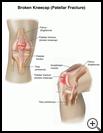
Kneecap (Patellar) Fracture
________________________________________________________________________
KEY POINTS
- A kneecap fracture is a break or crack in the kneecap.
- Treatment may include medicine, physical therapy, a brace, or sometimes surgery.
- To help prevent injury, your child should wear protective equipment that fits properly when playing sports. Your child should also stretch before and after physical activity.
________________________________________________________________________
What is a kneecap fracture?
A kneecap fracture is a break or crack in the kneecap (patella). It may be just a small crack in the bone, or the bone may break into pieces or shatter. Some fractures may stick out through the skin.
A kneecap fracture is also called a patellar fracture.
What is the cause?
A broken kneecap usually results from a fall onto the knee or a direct hit to the knee. Some kneecap fractures can happen when your child is jumping or running.
What are the symptoms?
Symptoms may include:
- A snapping or popping sound at the time of the injury
- Pain, swelling, bruising, or tenderness that happens right after the injury
- Trouble walking or straightening the leg
How is it diagnosed?
Your child’s healthcare provider will ask about your child’s symptoms and medical history and examine your child. Tests may include X-rays or other scans.
How is it treated?
The treatment depends on the type of fracture.
- If your child has an open wound with the fracture, he or she may need treatment to control bleeding or prevent infection.
- Your child may need surgery to:
- Remove all small fragments of bone
- Wire the kneecap fragments together, if possible
- Remove the kneecap if it has shattered
- Your child’s leg may be put in a brace, splint, knee immobilizer, or cast to keep his knee from moving while it heals. Your child should use crutches or a cane as directed by the healthcare provider.
Your child’s healthcare provider may prescribe pain medicine.
With treatment, the fracture may take 6 to 8 weeks to heal. Your child may need to do special exercises to help the leg get stronger and more flexible. Ask your child’s healthcare provider about this.
How can I take care of my child?
Follow the full course of treatment prescribed by your child’s provider. In addition:
To keep swelling down and help relieve pain:
- Put an ice pack, gel pack, or package of frozen vegetables wrapped in a cloth on the injured area every 3 to 4 hours for up to 20 minutes at a time for 3 days after the injury.
- When your child sits or lies down, he or she should keep the injured leg up on pillows so that it is above the level of the heart. Keep the knee straight.
- Give your child pain medicine as directed by the healthcare provider.
Ask your child’s healthcare provider:
- How and when you will get your child’s test results
- How long it will take to recover
- What activities your child should avoid and when your child can return to normal activities
- How to take care of your child at home
- What symptoms or problems you should watch for and what to do if your child has them
Make sure you know when your child should come back for a checkup. Keep all appointments for provider visits or tests.
How can I help prevent a kneecap fracture?
Most broken kneecaps are caused by accidents that are not easy to prevent. However, to help prevent injury, make sure that your child does the following:
- Wears shoes that fit well and give good support
- Gently stretches before and after physical activity
- Wears protective equipment that fits properly if he or she plays sports
Last modified: 2020-01-30
Last reviewed: 2019-04-29

